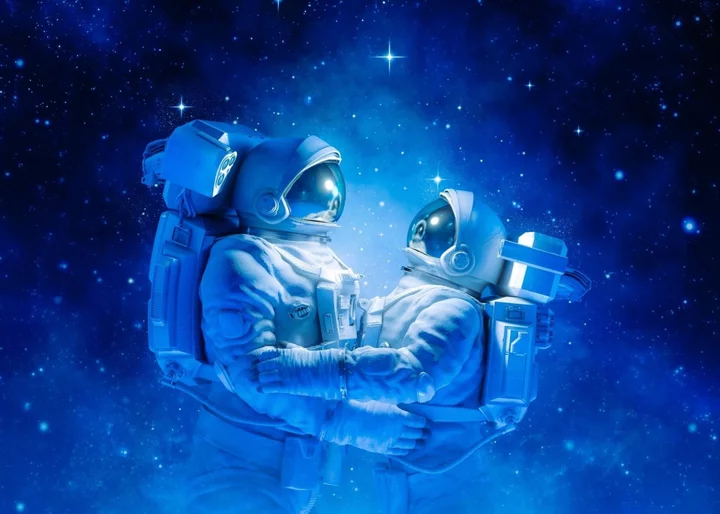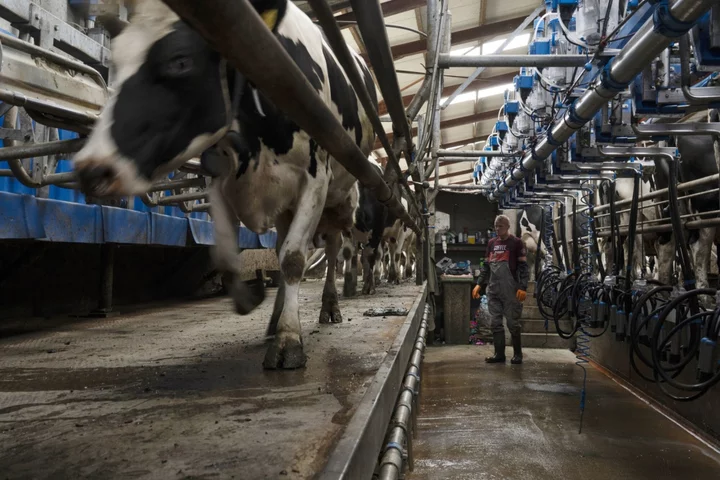During his first morning on the space shuttle Discovery, astronaut Mike Mullane woke up with a massive hard-on.
Scientists once questioned whether erections would be possible in space because blood and fluids shift and redistribute through the body without gravity. Hormones that increase one's sex drive also plummet. But a few male astronauts have opened up about the changes they have observed in their own anatomy. Not only is it possible to get aroused in space, but sometimes the environment has a turboing effect, giving rise to a nickname for the experience: space Viagra.
"I had an erection so intense it was painful," Mullane said in his book Riding Rockets. "I could have drilled through kryptonite."
NASA, on the other hand, would rather not talk about sex. That has been its modus operandi for the past 60 years of sending humans into space. No one to its knowledge has ever joined the hundreds-of-miles-high club, according to NASA, though contrary to popular belief, the agency has no formal policy regarding sexual activity in space, said Sandra Jones, a NASA Johnson Space Center spokeswoman.
"We depend and rely on the professionalism and good judgment of our astronauts," she told Mashable.
But, here we are, in an age when the U.S. space agency is preparing for long-duration missions to the moon and Mars, crewed by both men and women, with no firsthand knowledge of how doing the deed in space works. Meanwhile, Blue Origin and Virgin Galactic are taking more and more civilians up to kiss the Karman line, where Earth’s atmosphere and outer space meet. SpaceX's Elon Musk dreams of settling Mars with his giant Starship. Commercial companies are making plans to build space hotels.
SEE ALSO: He didn't live to see NASA's futuristic mission, but his ashes will join it in spaceFor years, experts thinking about the future survival of the species have called on NASA to get its head out of the clouds and commit to formally studying sex in outer space. But perhaps now the need for research is more obvious.
"We know what people do at hotels on Earth," said Dr. Shawna Pandya, director of medical research for Above Space Development, while speaking on a South by Southwest panel in March. "It seems kind of ridiculous to say that we're going to try to mandate what people can and can't do in space hotels off Earth. If we were making the argument that this question wasn't relevant or timely before, it absolutely is now."
"I had an erection so intense it was painful. I could have drilled through kryptonite."Is sex possible in space?
In the absence of science, rumors have filled the void.
Despite not having any confirmed cases of sex in space, doctors generally believe it's possible. Weightlessness might create a few awkward challenges, all likely surmountable with the ingenuity of clever people. After all, it was a rocket scientist who invented the Astroglide lubricant.
The obstacle is Newton's third law of motion: For every action, there is an equal and opposite reaction. On Earth, gravity and bodyweight create pressure that aids in missionary, cowgirl, and practically every other sex position. But in zero gravity, two people pushing against each other will float away. Because of this, sex would probably require strategies to keep the participants from drifting apart every time they thrust.
The relatively boring solution is already a status quo design element of the International Space Station. Walls are covered in Velcro, so all one might need to do is mount a consenting partner to the sticky surface. But space experts have, of course, considered other options, too.
Pandya suggested the technique and devices astronauts are trained to use for CPR could serve a dual purpose. In a recent TikTok video, Italian astronaut Samantha Cristoforetti demonstrated how the crew would handle rescue breaths and chest compressions in an emergency situation. One method involved completely inverting and pushing off the ceiling with her feet to press down on a patient's chest. Another method uses a "CPR bench," which Cristoforetti said is always deployed in the cabin, and includes a side strap to tether the rescuer to the equipment.
Want more science and tech news delivered straight to your inbox? Sign up for Mashable's Light Speed newsletter today.
"There's plenty of ways to actually make sexual interaction in space feasible." Astronaut Josh Cassada practices CPR during a 2022 drill on the International Space Station. Credit: NASAGerman astronaut Ulrich Walter once said in an interview with NDR, a German public broadcaster, that humans could look to the animal kingdom for inspiration. For example, sometimes a third dolphin will help hold two other dolphins together in the ocean to facilitate mating. Perhaps humans' hands, arms, and legs — instead of flippers — make a threesome less of a necessity, but props to Walter for thinking outside the monoamorous box.
The late Vanna Bonta, a science fiction author and actor, made the so-called 2Suit, a garment for assisting with space sex, after going on a parabolic flight with the National Space Society in 2004. The invention is a flight suit with a front flap that can open and attach to another such suit with Velcro. The garment was designed with internal harnesses and ways to attach the wearer to other surfaces. In 2008, Bonta wore a 2Suit during a History Channel documentary.
"There's plenty of ways to actually make sexual interaction in space feasible," said Simon Dube, a psychologist and research fellow at Indiana University's Kinsey Institute, who was also a SXSW panelist. "We can think about the sleeping bags in which the astronauts sleep on the International Space Station. (They're) pretty small. Two people could probably fit in and stay close to one another."
Astronaut Ron Garan sleeps in a sleeping bag on the International Space Station. Credit: NASANASA's stance on astronaut sex in space
But NASA probably hasn't talked about the off-label uses of the space station's sleeping accommodations since 1985. As the agency prepared to send women to work together with men at the future space station, suddenly the possibility of sexual activity became a talking point (Did people in the 1980s not think all-male crews could engage in sexual activity?). NASA researcher Yvonne Clearwater wrote in Psychology Today that the agency should assume a "group of normal, healthy professionals will probably possess normal, healthy sexual appetites."
"Someone will want to be the first."She and other psychologists, engineers, and an architect advising on the space station's design considered two-person sleeping compartments outfitted with soundproof materials.
"If we lock people up for 90-day periods, we must plan for the possibility of intimate behavior," Clearwater wrote then.
Journalists went on a tear reporting about the article with pun-filled headlines (Zero G-spot, anyone? The Big 'Bang?'). But the idea of astronaut intercourse on the taxpayer's dime apparently didn't go over as well with Congress. A New York Times story published seven years later quoted an anonymous source, who said a NASA staffer was assigned for six months to deal with the political backlash.
Japanese astronaut Koichi Wakata straps into a sleeping bag in his ISS sleep station in January 2014. Credit: NASA / Koichi WakataCan people get sexually aroused in space?
As titillating as the topic is, some have speculated that getting in the mood might be difficult. Astronauts often feel spacesick and dirty. Remember, there are no showers on the space station — only wet wipes and rinseless shampoo. Meanwhile, NASA spacefarers are expected to work up a sweat for at least two hours a day on a treadmill or stationary bicycle to combat bone and muscle deterioration.
Astronaut Bob Hines described what happens to bodily fluids in microgravity in a Youtube video for the Museum of Science in Boston last year. On Earth, sweat drips down one's face, and clothes wick away a lot of the moisture. But in space, surface tension keeps that liquid close. Furthermore, the lack of convection in space means heat surrounds people like an aura, causing astronauts to perspire more than usual.
"If we lock people up for 90-day periods, we must plan for the possibility of intimate behavior."For Hines, those juices would pool over his hair while he exercised.
"If I let it go long enough, I would end up with like this jelly kind of helmet on the top of my head," he said. "So while I'm running, I could feel it just jiggling back and forth up there."
"I could feel it just jiggling back and forth up there."Applying this knowledge to other bodily fluids, one could assume that female arousal — and, thus, getting wet — feels different, too. Natural genital lubrication would likely collect in similar globs or droplets. But data and personal accounts on what happens to cervical fluids and other vaginal secretions in space are hard to find, even in academic literature on menstruating astronauts (who, by the way, often opt to defer their periods altogether with oral contraception until they return to Earth).
Sexual curiosity is perhaps as innately human as the drive to explore the cosmos. Maybe that's why the public is so skeptical of space agencies when they say it's never happened before.
"Someone will want to be the first — the first to copulate in space, the first to conceive in space, the first to deliver in space," Pandya said. "If we're not figuring this out ethically … then we're also setting ourselves up for trouble later."









